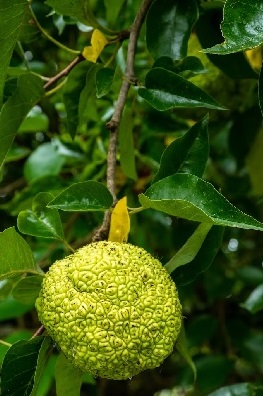Osage orange trees are still common throughout much of the United States, though not many people appreciate just how much the thorny, dense trees have shaped our country. Before Christopher Columbus’ arrival, Osage orange had a limited range in the Red River basin in Arkansas, Oklahoma and Texas. Like the droves of Europeans who followed, the tree eventually spread to all corners of our country, so long as you don’t count Alaska and Hawaii.
The thorny, dense trees go by a number of names, including hedge trees, prairie hedge, hedge apple, horse apple, bowwood or yellow wood for the hue of the heartwood. Whatever moniker you choose, the trees were the original barbed wire. After sprouting, the hedge trees were aggressively pruned to promote thick growth that was woven into a living fence considered to be “horse high, bull strong and hog tight”.
Even after the widespread adoption of barbed wire, wood from the hedge tree is still highly prized for fence posts based on its ability to withstand the elements. Termites and other insects don’t bother the wood. Water doesn’t penetrate the dense grain either.
Today, a post made from Osage orange is likely to outlast the strands of barbed wire attached to it. In fact, the posts can be difficult if not impossible to work with if they’re left to season too long after cutting. Hedge posts don’t decay, rather they almost petrify into something between wood and stone.
Osage orange’s qualities extend well beyond corralling cattle and other livestock. Its tight grain makes the wood extraordinarily flexible, enough so that a bow made from the tree was worth a horse and blanket in the 1800s. Osage orange also offers the highest heat value of any species when burned as firewood.
Osage orange is probably the most popular and widely distributed plant that isn’t a food source for either humans or animals. Its fruit is a softball-sized green ball with folded contours that surround a cluster of seeds. We called them brain blobs growing up because the outer shell consisted of folded contours. They were dense and would make a satisfying sound when flung into a tree trunk. They’ll start falling off trees any day this time of year.
Rumor has it the fruits keep all sorts of creepy-crawlies away, from boxelder bugs and crickets to spiders and other pests, especially when placed in basements or near the foundation of a home. Research has yet to find any evidence to support those claims, yet the legends endure.
Steel T-posts and pipe braces are gaining favor, but some still prefer to use hedge posts for fencing. Composite compound bows can launch an arrow with a much greater force than the traditional longbow, yet Osage orange bow staves are still readily available. The living fencerows are long gone, but hedge trees planted during the Great Depression as windbreaks still mark the edges of fields.
There’s no one quality that has seeded the Osage orange across the countryside, rather versality is its main attribute. From hedge to post or bow to kindling, mankind has found it useful for centuries. While modern materials will eventually win out, they won’t ever have a history quite like hedge.
_ _ _
Photo by Joe Parkin on Unsplash



